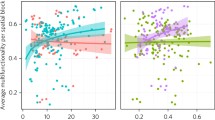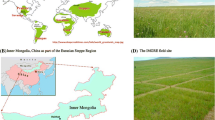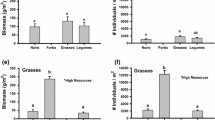Abstract
Ecosystems provide multiple services upon which humans depend. Understanding the drivers of the ecosystem functions that support these services is therefore important. Much research has investigated how species richness influences functioning, but we lack knowledge of how other community attributes affect ecosystem functioning. Species evenness, species spatial arrangement, and the identity of dominant species are three attributes that could affect ecosystem functioning, by altering the relative abundance of functional traits and the probability of synergistic species interactions such as facilitation and complementary resource use. We tested the effect of these three community attributes and their interactions on ecosystem functions over a growing season, using model grassland communities consisting of three plant species from three functional groups: a grass (Anthoxanthum odoratum), a forb (Plantago lanceolata), and a N-fixing forb (Lotus corniculatus). We measured multiple ecosystem functions that support ecosystem services, including ecosystem gas exchange, water retention, C and N loss in leachates, and plant biomass production. Species evenness and dominant species identity strongly influenced the ecosystem functions measured, but spatial arrangement had few effects. By the end of the growing season, evenness consistently enhanced ecosystem functioning and this effect occurred regardless of dominant species identity. The identity of the dominant species under which the highest level of functioning was attained varied across the growing season. Spatial arrangement had the weakest effect on functioning, but interacted with dominant species identity to affect some functions. Our results highlight the importance of understanding the role of multiple community attributes in driving ecosystem functioning.






Similar content being viewed by others
References
Amundson R (2001) The carbon budget in soils. Annu Rev Earth Planet Sci 29:535–562
Avis EL, Harrop SE (1983) Sheet 1, Northern England. Soils of England and Wales, Ordnance Survey, Southampton
Bachman S, Heisler-White JL, Pendall E, Williams DG, Morgan JA, Newcomb J (2010) Elevated carbon dioxide alters impacts of precipitation pulses on ecosystem photosynthesis and respiration in a semi-arid grassland. Oecologia 162:791–802
Bardgett RD, van der Wal R, Jonsdottir IS, Quirk H, Dutton S (2007) Temporal variability in plant and soil nitrogen pools in a high-Arctic ecosystem. Soil Biol Biochem 39:2129–2137
Bardgett RD, Freeman C, Ostle NJ (2008) Microbial contributions to climate change through carbon cycle feedbacks. ISME J 2:805–814
Cardinale BJ, Wright JP, Cadotte MW, Carroll IT, Hector A, Srivastava DS, Loreau M, Weis JJ (2007) Impacts of plant diversity on biomass production increase through time because of species complementarity. PNAS 104:18123–18128
Cardinale BJ, Matulich KL, Hooper DU, Byrnes JE, Duffy E, Gamfeldt L, Balvanera P, O’Connor MI, Gonzalez A (2011) The functional role of producer diversity in ecosystems. Am J Bot 98:572–592
Chapin FS, Zavaleta ES, Eviner VT, Naylor RL, Vitousek PM, Reynolds HL, Hooper DU, Lavorel S, Sala OE, Hobbie SE, Mack MC, Diaz S (2000) Consequences of changing biodiversity. Nature 405:234–242
Crawley MJ (2007) The R book. Wiley, Chichester
Dangles O, Malmqvist B (2004) Species richness-decomposition relationships depend on species dominance. Ecol Lett 7:395–402
De Boeck HJ, Nijs I, Lemmens C, Ceulemans R (2006) Underlying effects of spatial aggregation (clumping) in relationships between plant diversity and resource uptake. Oikos 113:269–278
De Deyn GB, Quirk H, Yi Z, Oakley S, Ostle NJ, Bardgett RD (2009) Vegetation composition promotes carbon and nitrogen storage in model grassland communities of contrasting soil fertility. J Ecol 97:864–875
Gamfeldt L, Hillebrand H, Jonsson PR (2008) Multiple functions increase the importance of biodiversity for overall ecosystem functioning. Ecology 89:1223–1231
Griffiths GJK, Wilby A, Crawley MJ, Thomas MB (2008) Density-dependent effects of predator species-richness in diversity-function studies. Ecology 89:2986–2993
Grime JP (2001) Plant strategies, vegetation processes, and ecosystem properties, 2nd edn. Wiley, Chichester
Harrison KA, Bardgett RD (2010) Influence of plant species and soil conditions on plant-soil feedback in mixed grassland communities. J Ecol 98:384–395
Hejda M, Pysek P, Jarosik V (2009) Impact of invasive plants on the species richness, diversity and composition of invaded communities. J Ecol 97:393–403
Hillebrand H, Matthiessen B (2009) Biodiversity in a complex world: consolidation and progress in functional biodiversity research. Ecol Lett 12:1405–1419
Hillebrand H, Gruner DS, Borer ET, Bracken MES, Cleland EE, Elser JJ, Harpole WS, Ngai JT, Seabloom EW, Shurin JB, Smith JE (2007) Consumer versus resource control of producer diversity depends on ecosystem type and producer community structure. PNAS 104:10904–10909
Hillebrand H, Bennett DM, Cadotte MW (2008) Consequences of dominance: a review of evenness effects on local and regional ecosystem processes. Ecology 89:1510–1520
Hooper DU, Chapin FS, Ewel JJ, Hector A, Inchausti P, Lavorel S, Lawton JH, Lodge DM, Loreau M, Naeem S, Schmid B, Setala H, Symstad AJ, Vandermeer J, Wardle DA (2005) Effects of biodiversity on ecosystem functioning: a consensus of current knowledge. Ecol Monogr 75:3–35
Isbell F, Calcagno V, Hector A, Connolly J, Harpole WS, Reich PB, Scherer-Lorenzen M, Schmid B, Tilman D, van Ruijven J, Weigelt A, Wilsey BJ, Zavaleta ES, Loreau M (2011) High plant diversity is needed to maintain ecosystem services. Nature 477:199–202
King RF, Dromph KM, Bardgett RD (2002) Changes in species evenness of litter have no effect on decomposition processes. Soil Biol Biochem 34:1959–1963
Kirwan L, Luescher A, Sebastia MT, Finn JA, Collins RP, Porqueddu C, Helgadottir A, Baadshaug OH, Brophy C, Coran C, Dalmannsdottir S, Delgado I, Elgersma A, Fothergill M, Frankow-Lindberg BE, Golinski P, Grieu P, Gustavsson AM, Hoglind M, Huguenin-Elie O, Iliadis C, Jorgensen M, Kadziuliene Z, Karyotis T, Lunnan T, Malengier M, Maltoni S, Meyer V, Nyfeler D, Nykanen-Kurki P, Parente J, Smit HJ, Thumm U, Connolly J (2007) Evenness drives consistent diversity effects in intensive grassland systems across 28 European sites. J Ecol 95:530–539
Lamošová T, Doležal J, Lanta V, Lepš J (2010) Spatial pattern affects diversity–productivity relationships in experimental meadow communities. Acta Oecol 36:325–332
Lavorel S, Garnier E (2002) Predicting changes in community composition and ecosystem functioning from plant traits: revisiting the Holy Grail. Funct Ecol 16:545–556
Maestre FT, Reynolds JF (2006) Spatial heterogeneity in soil nutrient supply modulates nutrient and biomass responses to multiple global change drivers in model grassland communities. Glob Change Biol 12:2431–2441
Maestre FT, Escudero A, Martinez I, Guerrero C, Rubio A (2005) Does spatial pattern matter to ecosystem functioning? Insights from biological soil crusts. Funct Ecol 19:566–573
Maestre FT, Castillo-Monroy AP, Bowker MA, Ochoa-Hueso R (2012) Species richness effects on ecosystem multi-functionality depend on evenness, composition and spatial pattern. J Ecol 100:317–330
Millennium Ecosystem Assessment (2005) Ecosystems and human well-being: synthesis. Island Press, Washington
Mokany K, Ash J, Roxburgh S (2008) Effects of spatial aggregation on competition, complementarity and resource use. Aust Ecol 33:261–270
Monzeglio U, Stoll P (2005) Spatial patterns and species performances in experimental plant communities. Oecologia 145:619–628
Mulder CPH, Bazeley-White E, Dimitrakopoulos PG, Hector A, Scherer-Lorenzen M, Schmid B (2004) Species evenness and productivity in experimental plant communities. Oikos 107:50–63
Nagase A, Dunnett N (2012) Amount of water runoff from different vegetation types on extensive green roofs: effects of plant species, diversity and plant structure. Landsc Urban Plan 104:356–363
Nijs I, Roy J (2000) How important are species richness, species evenness and interspecific differences to productivity? A mathematical model. Oikos 88:57–66
Orwin KH, Wardle DA (2005) Plant species composition effects on belowground properties and the resistance and resilience of the soil microflora to a drying disturbance. Plant Soil 278:205–221
Orwin KH, Buckland SM, Johnson D, Turner BL, Smart S, Oakley S, Bardgett RD (2010) Linkages of plant traits to soil properties and the functioning of temperate grassland. J Ecol 98:1074–1083
Polley HW, Wilsey BJ, Derner JD (2003) Do species evenness and plant density influence the magnitude of selection and complementarity effects in annual plant species mixtures? Ecol Lett 6:248–256
R Development Core Team (2007) R: a language and environment for statistical computing. R Foundation for Statistical Computing, Vienna (http://www.r-project.org)
Rodwell JS (1992) Grasslands and montane communities. British Plant Communities, Cambridge
Shaw MR, Zavaleta ES, Chiariello NR, Cleland EE, Mooney HA, Field CB (2002) Grassland responses to global environmental changes suppressed by elevated CO2. Science 298:1987–1990
Smit HJ, Metzger MJ, Ewert F (2008) Spatial distribution of grassland productivity and land use in Europe. Agric Syst 98:208–219
Stoll P, Prati D (2001) Intraspecific aggregation alters competitive interactions in experimental plant communities. Ecology 82:319–327
Walker MD, Wahren CH, Hollister RD, Henry GHR, Ahlquist LE, Alatalo JM, Bret-Harte MS, Calef MP, Callaghan TV, Carroll AB, Epstein HE, Jonsdottir IS, Klein JA, Magnusson B, Molau U, Oberbauer SF, Rewa SP, Robinson CH, Shaver GR, Suding KN, Thompson CC, Tolvanen A, Totland O, Turner PL, Tweedie CE, Webber PJ, Wookey PA (2006) Plant community responses to experimental warming across the tundra biome. PNAS 103:1342–1346
Ward SE, Bardgett RD, McNamara NP, Adamson JK, Ostle NJ (2007) Long-term consequences of grazing and burning on northern peatland carbon dynamics. Ecosystems 10:1069–1083
Ward SE, Ostle NJ, McNamara NP, Bardgett RD (2010) Litter evenness influences short-term peatland decomposition processes. Oecologia 164:511–520
White RP, Murray S, Rohweder M (2000) Pilot Analysis of global ecosystems: grassland ecosystems. World Resources Institute, Washington, DC
Wilby A, Orwin KH (2013) Herbivore species richness, composition and community structure mediate predator richness effects and top-down control of herbivore biomass. Oecologia 172:1167–1177
Wilsey BJ, Polley HW (2004) Realistically low species evenness does not alter grassland species-richness-productivity relationships. Ecology 85:2693–2700
Wilsey BJ, Potvin C (2000) Biodiversity and ecosystem functioning: importance of species evenness in an old field. Ecology 81:887–892
Yachi S, Loreau M (1999) Biodiversity and ecosystem productivity in a fluctuating environment: the insurance hypothesis. PNAS 96:1463–1468
Yurkonis KA, Wilsey BJ, Moloney KA (2012) Initial species pattern affects invasion resistance in experimental grassland plots. J Veg Sci 23:4–12
Zhang Y, Chen HYH, Reich PB (2012) Forest productivity increases with evenness, species richness and trait variation: a global meta-analysis. J Ecol 100:742–749
Acknowledgments
We thank Franciska de Vries, Helen Quirk, Melanie Hartley, Victor Van Velsen, and Jorge Paz-Ferreiro for assistance with setting up the mesocosms, and Juliette Bloor, Matt Naish, Sue Ward, and Paul Webb for assistance with function measurements. We also thank two anonymous referees for helpful comments on the manuscript. The experiments comply with the current laws of the country (UK) in which the experiment was performed.
Author information
Authors and Affiliations
Corresponding author
Additional information
Communicated by Bryan Foster.
Electronic supplementary material
Below is the link to the electronic supplementary material.
Rights and permissions
About this article
Cite this article
Orwin, K.H., Ostle, N., Wilby, A. et al. Effects of species evenness and dominant species identity on multiple ecosystem functions in model grassland communities. Oecologia 174, 979–992 (2014). https://doi.org/10.1007/s00442-013-2814-5
Received:
Accepted:
Published:
Issue Date:
DOI: https://doi.org/10.1007/s00442-013-2814-5




